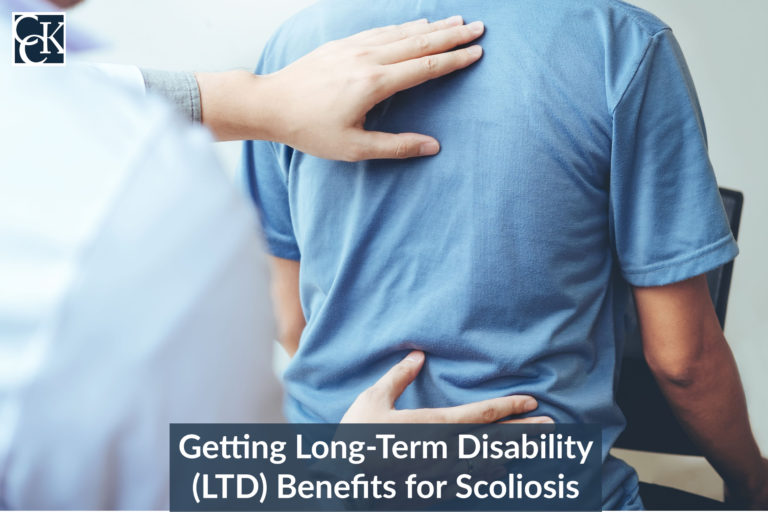Getting Long-Term Disability (LTD) Benefits for Scoliosis

Scoliosis is a sideways curvature of the spine that can impact the structure of the rest of your body and lead to disabling effects. Scoliosis effects an estimated six to nine million people in the United States, according to the American Association of Neurological Surgeons. It is often thought of as a condition found mostly in children and adolescents, and while it is common in younger people, scoliosis can affect the older half of the population as well.
If you have scoliosis and it is disabling you enough to impact your ability to work, you may be eligible for long-term disability (LTD) benefits. At Chisholm Chisholm & Kilpatrick, our attorneys have the experience and knowledge to help you build a strong long-term disability claim. For a free consultation, you can contact us at 800-544-9144.
What is Scoliosis?
Scoliosis is a sideways curvature of the spine and often occurs in preadolescents during their growth spurt just before puberty. This is known as idiopathic scoliosis, and while it is often caught during youth, it may also be diagnosed later if the curve becomes more pronounced as one grows into adulthood. While idiopathic scoliosis is primarily found in adolescents, another type of scoliosis, degenerative scoliosis, can affect the older population.

Degenerative scoliosis, also known as adult-onset scoliosis, is when the curvature of the spine is caused by the degeneration of the joints and discs in the spine, often in the lower back. This often occurs as a person ages and is not related to idiopathic scoliosis. It is believed that about 60 percent of people over sixty years old have some mild form of degenerative scoliosis, but as symptoms are often undetected or not severe, it is often not diagnosed. However, for those who develop severe degenerative scoliosis, it can be painful and debilitating.
Both forms of this condition can lead to skeletal, organ, and nerve damage if not treated sufficiently. In severe cases, the deformation of your spine can put pressure on other bones, such as the rib cage. Your rib cage may then press on your heart or lungs, which can cause trouble with breathing and circulation and can lead to organ damage. Scoliosis may also damage the spinal cord or root nerves, which can be dangerous for nerve function. Pressure on your spinal nerves due to scoliosis can cause numbness and can be extremely painful. You may feel pain or numbness radiating in your legs or buttocks, in particular. This is commonly known as sciatic pain or radiculopathy and is more common in degenerative scoliosis. Scoliosis can cause permanent nerve damage if left untreated.
Scoliosis may be a side effect of other disorders, such as neuromuscular conditions like cerebral palsy or muscular dystrophy. It may also be caused by birth defects or injuries or infections of the spine. It is often genetic, but it is not uncommon for it to occur in individuals who have no family history of the condition.
Symptoms of Scoliosis
Symptoms of idiopathic scoliosis may include:
- A visibly curved spine
- Uneven shoulders, waist, or hips
- The Head is not centered directly above the pelvis
- Uneven prominence of the ribcage
- The body leans to one side
- Back pain
Symptoms of degenerative scoliosis may include any of the above symptoms, as well as:
- Pain or stiffness located in the lower back that increases gradually over time
- Pain after periods of inactivity or after strenuous activity
- Pain while walking
- Changes in posture, including becoming shorter
- Sharp pain or tinging in the leg or buttock
These symptoms may develop gradually over a long period of time, especially in the case of the degenerative form, which occurs with age.
How is Scoliosis Diagnosed?
Children and teens are routinely evaluated for scoliosis, which may consist of a physical evaluation of posture, growth, strength, and balance. A further neurological exam may consist of checking for muscle weakness, numbness, and abnormal reflexes. These same evaluations may be used in diagnosing degenerative scoliosis, except they may also be used to rule out other musculoskeletal or neurological conditions that often occur with age.
Further testing may consist of an MRI, CT scan, or X-rays. These can show a detailed look at the spine that will aid treatment of your specific condition and may reveal damaged vertebrates, especially in degenerative scoliosis.
Treatment for Scoliosis
Treatment for scoliosis can depend on its severity. A back brace may be required to help straighten or relieve pain caused by the unnatural curvature. Physical therapy may also be suggested to help relieve pain and strengthen the back. Particularly in degenerative scoliosis, pain-relieving medication or injections may be prescribed.
In severe cases, often when the spine is curved over 40 degrees, surgery may be required. Spinal fusion surgery is the most common surgery performed for scoliosis. In spinal fusion surgery, the spine is straightened and stabilized with metal rods and screws while old and new bone material fuse together, healing into a straight spine. Recovery from spinal fusion surgery often takes six to twelve months.
More commonly in degenerative scoliosis, lumbar decompression surgery may be performed. In decompression surgery, a small part of the vertebrate is removed to relieve stress on the spinal cord or root nerves. This will bring relief from nerve pain or numbness. Lumbar decompression surgery is often performed in combination with spinal fusion surgery so that further compression of the nerves does not occur. Some adults who may have been treated for scoliosis as children 20 to 30 years ago, before major advancements in spinal surgery, may require revision surgery also consisting of spinal fusion surgery.
Long-Term Disability and the Effects of Scoliosis
Scoliosis can range largely in its severity, but its effects can be debilitating. If your condition is hindering your ability to perform the functions of your job, you may be able to file for long-term disability benefits.

Scoliosis can hinder a physical or sedentary occupation. Pressure from a curved spine may damage your nerves. This can cause pain, weakness, and numbness which can impede physical job duties that require frequent movement, lifting, or being on your feet for long periods of time. Trouble walking, moving, and breathing due to nerve damage and bone disfiguration can be extremely debilitating, and can also cause major discomfort in a sedentary job. Pain from this condition may cause discomfort while sitting for long periods and can impede work that requires a high level of concentration. You will want to include evidence that proves such incapacitating effects in your claim, which may be provided through medical evaluations or an assessment by a vocational expert.
Treatment and doctor’s appointments for your scoliosis may keep you out of work, and if you require surgery, recovery time can take as long as twelve months. You will want to document such instances for your claim to prove how your scoliosis is interfering with your job. If your scoliosis stems from another condition, such as a neurological condition or another degenerative bone condition, you should include the disabling symptoms you have from all conditions. You want to provide as much evidence as possible on your claim so that you have the best chance of being approved for long-term disability benefits.
How Chisholm Chisholm & Kilpatrick Can Help You with Your Long-Term Disability Claim
The legal team at CCK has experience working with long-term disability claims for numerous conditions, including scoliosis. We understand that scoliosis can be a distressing condition to live with and want to make the process of filing for long-term disability benefits as easy for you as possible. We have experience obtaining evidence for your claim, handling the communication between your insurance company and doctors, and making sure that all necessary requirements for your claim are met.

Our long-term disability lawyers will evaluate your policy to ensure that the evidence you provide satisfies your definition of disability. This definition is crucial and sets the terms your condition must meet for your claim to be approved by your insurance company. We can help you gather additional evidence from various medical and vocational experts, who can provide supplemental evaluations of your condition and assess your ability to perform your job.
Our attorneys are experienced in ERISA law, which governs many long-term disability claims. Under ERISA, the appeal is the last stage you are able to submit evidence before your claim is taken to court. Our lawyers will ensure you submit all necessary documentation, as insufficient evidence or a missed deadline can lead to a claim denial. Whether you are filing your initial claim or appealing a denial of benefits due to scoliosis, CCK has the knowledge and experience to help you.
Call CCK Today for a Free Consultation
Our attorneys know that filing for long-term disability can be a difficult process, particularly when you are also managing the effects of your scoliosis. We want to take the burden of filing for long-term disability insurance off you so that you can focus on your health and well-being. The legal team at CCK is prepared to fight for the long-term disability benefits you deserve. For a free consultation, call 800-544-9144 today.
Share this Post
